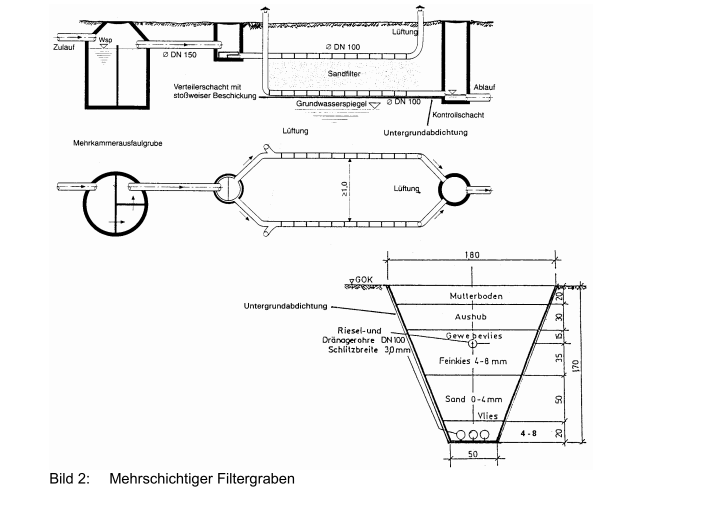- Sanitation systems
- Treatment of wastewater, sludges, organic waste, excreta
- Decentralised wastewater treatment systems (anaerobic and aerobic), DEWATS
- More compact DEWATS technology?
More compact DEWATS technology?
52k views
Was looking for constructed wetland variations that avoid having to buy large quantities of sand and came across this:
www.wastewatertreatment.co.in/pdf/Treatm...cted-soil-filter.pdf
(laterite is the common red base-layer soil found in tropical countries, called murram here in East Africa).
Due to the deeper depth of the filter-bed it might have a higher pathogen removal per surface area, otherwise it is similar to a vertical flow constructed wetland.
www.wastewatertreatment.co.in/pdf/Treatm...cted-soil-filter.pdf
(laterite is the common red base-layer soil found in tropical countries, called murram here in East Africa).
Due to the deeper depth of the filter-bed it might have a higher pathogen removal per surface area, otherwise it is similar to a vertical flow constructed wetland.
This message has an attachment file.
Please log in or register to see it.
Please Log in to join the conversation.
You need to login to reply
Dear all,
Thanks for your inputs, we are not anywhere close to an actual project and I just wanted to double check that there is no "simple" solution. If this gets more serious I will pick up the question again.
One issue here with DEWATS in the Kathmandu valley is that land prices have sky-rocketed in the last 10 years. Making it much harder to use low-tech space intensive solutions. At the same time, apart from real-estate prices the economy has not grown very much. So we have a situation in which land is expensive, power most of the winter only available for 6-8 hours per day and also very few capable firms to run more complicated technology. What to do ?
@ Christoph, thanks these may be a solution in rural health posts, which a friend of mine is looking at.
@Freya, How are you? Yes I remember the days at ENPHO, if this ever gets serious I will definitely contact them.
There is some very interesting and cool stuff going on in hospital waste management in Nepal at the moment. My question was in relation to trying to include waste water treatment into hospital waste management systems; which look like they are moving beyond the pioneering stage.
Regards
Marijn
Thanks for your inputs, we are not anywhere close to an actual project and I just wanted to double check that there is no "simple" solution. If this gets more serious I will pick up the question again.
One issue here with DEWATS in the Kathmandu valley is that land prices have sky-rocketed in the last 10 years. Making it much harder to use low-tech space intensive solutions. At the same time, apart from real-estate prices the economy has not grown very much. So we have a situation in which land is expensive, power most of the winter only available for 6-8 hours per day and also very few capable firms to run more complicated technology. What to do ?
@ Christoph, thanks these may be a solution in rural health posts, which a friend of mine is looking at.
@Freya, How are you? Yes I remember the days at ENPHO, if this ever gets serious I will definitely contact them.
There is some very interesting and cool stuff going on in hospital waste management in Nepal at the moment. My question was in relation to trying to include waste water treatment into hospital waste management systems; which look like they are moving beyond the pioneering stage.
Regards
Marijn
Marijn Zandee
E: This email address is being protected from spambots. You need JavaScript enabled to view it.
E: This email address is being protected from spambots. You need JavaScript enabled to view it.
Please Log in to join the conversation.
You need to login to reply- Freya
-

- WASH Research Consultant ISF-UTS
Less- Posts: 10
- Karma: 1
- Likes received: 12
Hi Marijn,
As you know I worked with local NGO ENPHO assessing DEWATS in Kathmandu in 2010. I agree it’s a difficult issue with tight space and uncertain power availability. However the systems at Dhulikhel and Susma Koirala hospitals in the Kathmandu Valley were working well enough. It would be worth testing the inflow/outflow from the ABR at Dhulikhel Hospital to assess the current treatment performance.
I can’t think of any specific solutions at this moment, but some suggestions from the other systems:
- I would not recommend Biogas since it requires a large area for limited treatment, which ABRs/AF could better provide.
- Disposal of medical waste could kill the bacteria. Parallel/batch systems could be beneficial, as well as waste management education. Rags were also an issue and blocked inlet screens regularly.
- Rainwater infiltration was high in the other hospitals, to maximise treatment improving the separation of streams would be important. (Testing at Dhulikhel in 2011 was after heavy rains and the results were obviously impacted by this)
Maybe contact the team at ENPHO for an update on the operation of the other hospitals or let me know if you want any background information.
Regards,
Freya Mills
As you know I worked with local NGO ENPHO assessing DEWATS in Kathmandu in 2010. I agree it’s a difficult issue with tight space and uncertain power availability. However the systems at Dhulikhel and Susma Koirala hospitals in the Kathmandu Valley were working well enough. It would be worth testing the inflow/outflow from the ABR at Dhulikhel Hospital to assess the current treatment performance.
I can’t think of any specific solutions at this moment, but some suggestions from the other systems:
- I would not recommend Biogas since it requires a large area for limited treatment, which ABRs/AF could better provide.
- Disposal of medical waste could kill the bacteria. Parallel/batch systems could be beneficial, as well as waste management education. Rags were also an issue and blocked inlet screens regularly.
- Rainwater infiltration was high in the other hospitals, to maximise treatment improving the separation of streams would be important. (Testing at Dhulikhel in 2011 was after heavy rains and the results were obviously impacted by this)
Maybe contact the team at ENPHO for an update on the operation of the other hospitals or let me know if you want any background information.
Regards,
Freya Mills
Please Log in to join the conversation.
You need to login to reply
Dear Marijn,
as you asked for simple secondary treatment solutions, which might be possible to be implanted under a parking lot, the only solution which comes into my mind are sandfilter trenches (Sandfiltergraben in german)published here for instance , the picture below gives an idea.
It is not a solution for large volumes and you should be sure tha you are able to have access to be able to clean out the sand...just in case of clogging due to overload!
The best is to guarantee pulse loading to those trenches (there are some simple siphons you can build for about 10 US), but still I would do a chlorination in the end with Hospital wastewater.
For larger volumes (as typical in a hospital) I think you can not avoid a more technical approach. I would go for SBR ... but that is another story - not low tech.
Yours Christoph
as you asked for simple secondary treatment solutions, which might be possible to be implanted under a parking lot, the only solution which comes into my mind are sandfilter trenches (Sandfiltergraben in german)published here for instance , the picture below gives an idea.
It is not a solution for large volumes and you should be sure tha you are able to have access to be able to clean out the sand...just in case of clogging due to overload!
The best is to guarantee pulse loading to those trenches (there are some simple siphons you can build for about 10 US), but still I would do a chlorination in the end with Hospital wastewater.
For larger volumes (as typical in a hospital) I think you can not avoid a more technical approach. I would go for SBR ... but that is another story - not low tech.
Yours Christoph
Attachments:
-
 sandfiltergraben.png
(Filesize: 74KB)
sandfiltergraben.png
(Filesize: 74KB)
The following user(s) like this post: AquaVerde
Please Log in to join the conversation.
You need to login to reply
Dear Marijn,
To have a much smaller footprint for the second treatment stage after ABR, you may "take out" the robust option, low-tech aerobic bio-film systems like CW's, who often do not have any power consumption.
You may go for other aerobic bio-film systems in compartments in the underground with artificial aeration (it needs external power for aeration to function proper, even if salesman claim the opposite, e.g. www.clearfox.info/english/products-8pe-CFnature.php)
this example is for domestic sewage only
or go for more high-tech systems like membrane technologies as Julius already mentioned, which need permanent power connection and a higher level of O&M as you know. Beside CWs, as fare I know only the high-tech plants will reach the right pathogenic level for hospitals.
So you have to compare the possible advantages of less space requirements with possible disadvantages of high-tech (less robust) very carefully.
Alternatively, how about pumping or draining the relatively "clean" effluent to a possible area with enough space for CW's?
If no alternatives available, unfortunately you have to go for the high-tech stuff. But maybe all is to expensive and not reliable enough and you may opt/suggest for relocation of hospital...
Just for a ponder, a good trail example of roof-CW by German CW-Engineer Mr. Blumberg: www.blumberg-engineers.com/PDF/Wetland_roofs.pdf
Maybe good "enough" for greywater treatment, but for hospital ABR effluent I would hesitate.
Good luck
Detlef
To have a much smaller footprint for the second treatment stage after ABR, you may "take out" the robust option, low-tech aerobic bio-film systems like CW's, who often do not have any power consumption.
You may go for other aerobic bio-film systems in compartments in the underground with artificial aeration (it needs external power for aeration to function proper, even if salesman claim the opposite, e.g. www.clearfox.info/english/products-8pe-CFnature.php)
this example is for domestic sewage only
or go for more high-tech systems like membrane technologies as Julius already mentioned, which need permanent power connection and a higher level of O&M as you know. Beside CWs, as fare I know only the high-tech plants will reach the right pathogenic level for hospitals.
So you have to compare the possible advantages of less space requirements with possible disadvantages of high-tech (less robust) very carefully.
Alternatively, how about pumping or draining the relatively "clean" effluent to a possible area with enough space for CW's?
If no alternatives available, unfortunately you have to go for the high-tech stuff. But maybe all is to expensive and not reliable enough and you may opt/suggest for relocation of hospital...
Just for a ponder, a good trail example of roof-CW by German CW-Engineer Mr. Blumberg: www.blumberg-engineers.com/PDF/Wetland_roofs.pdf
Maybe good "enough" for greywater treatment, but for hospital ABR effluent I would hesitate.
Good luck
Detlef
www.aqua-verde.de, AquaVerde Ltd. Zanzibar
"simple" Sanitation-Solutions by gravity
Low-Tech Solutions with High-Tech Effects
"Inspired by Circular Economy and Cooperation"
www.flickr.com/photos/aqua-verde/
"simple" Sanitation-Solutions by gravity
Low-Tech Solutions with High-Tech Effects
"Inspired by Circular Economy and Cooperation"
www.flickr.com/photos/aqua-verde/
Please Log in to join the conversation.
You need to login to reply
Especially since we are talking about a hospital (e.g. increased effluent safety requirements), the only solution I can think of would be a (relatively expensive) MBR: en.wikipedia.org/wiki/Membrane_bioreactor
Please Log in to join the conversation.
You need to login to reply- Frapoberlin
-

- Consultant Water & Environment / Hanoi, Vietnam
Less- Posts: 11
- Likes received: 4
Dear Marijn,
good question and I am curious to hear the answers.
In my view, "simple" and "little space requirements" are a contradiction in terms.
I have never heard of a second treatment step after an DEWATS ABR other then constructed wetland or (aerated) pond.
Soil infiltration might be an option, but usually the effluent quality from ABRs is not good enough.
There is absolutely no space for a nice reed bed around? I have seen solutions being part of the landscaping in a hospital area, along the fences and walls.
Regards
Frank
good question and I am curious to hear the answers.
In my view, "simple" and "little space requirements" are a contradiction in terms.
I have never heard of a second treatment step after an DEWATS ABR other then constructed wetland or (aerated) pond.
Soil infiltration might be an option, but usually the effluent quality from ABRs is not good enough.
There is absolutely no space for a nice reed bed around? I have seen solutions being part of the landscaping in a hospital area, along the fences and walls.
Regards
Frank
Frank Pogade
Consultant Water & Environment
Saigon / Vietnam
www.watersolutions-int.org
Consultant Water & Environment
Saigon / Vietnam
www.watersolutions-int.org
Please Log in to join the conversation.
You need to login to reply
Dear all,
I was recently asked if a decentralized waste water treatment system could be installed at a hospital here in Kathmandu. There are some examples of DEWATS systems in the area, but they all rely on wetlands for secondary treatment. These wetland obviously take up a lot of space.
The issue is that we are looking at a building inside the city, which is very densely built-up. We could probably fit an ABR (with or without methane capture)under a parking lot or by sacrificing some basement space. But in the context here, the system would only make sense if we can produce an effluent that can be safely infiltrated into the soil (or disposed into the river), for which secondary treatment will be required.
My question, is there a simple, reliable secondary treatment option which requires very little space that I am overlooking?
I was recently asked if a decentralized waste water treatment system could be installed at a hospital here in Kathmandu. There are some examples of DEWATS systems in the area, but they all rely on wetlands for secondary treatment. These wetland obviously take up a lot of space.
The issue is that we are looking at a building inside the city, which is very densely built-up. We could probably fit an ABR (with or without methane capture)under a parking lot or by sacrificing some basement space. But in the context here, the system would only make sense if we can produce an effluent that can be safely infiltrated into the soil (or disposed into the river), for which secondary treatment will be required.
My question, is there a simple, reliable secondary treatment option which requires very little space that I am overlooking?
Marijn Zandee
E: This email address is being protected from spambots. You need JavaScript enabled to view it.
E: This email address is being protected from spambots. You need JavaScript enabled to view it.
Please Log in to join the conversation.
You need to login to reply
Share this thread:
- Sanitation systems
- Treatment of wastewater, sludges, organic waste, excreta
- Decentralised wastewater treatment systems (anaerobic and aerobic), DEWATS
- More compact DEWATS technology?
Recently active users. Who else has been active?
Time to create page: 0.208 seconds









